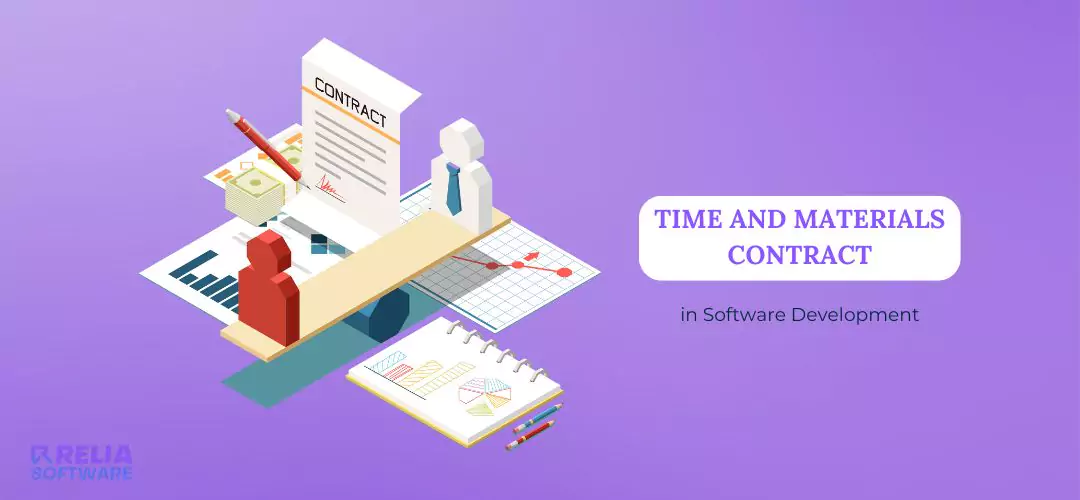You are uncertain about the project scope? Pinpointing costs and timelines can be tricky? Fortunately, Time and Materials (TM) contracts offer a flexible solution for software development. This guide unpacks the benefits, best practices, and how to leverage TM contracts for a smooth and successful development process.
>> Read more:
- Managed IT Services Explained: Key for Business Success
- The Comparison of Staff Augmentation VS Managed Services
- Staff Augmentation VS. Outsourcing: Which Is Better?
- IT Staff Augmentation: Development Team Growth Method
What is A Time and Materials Contract?
In a software development context, a Time and Materials (TM) contract is an agreement between a client and a development team where the client pays for the actual time spent working on the project and the materials used. This differs from a fixed-price contract where the total cost is set upfront regardless of the time or resources required.
The purpose of a TM contract in software development is to provide flexibility when the project scope is uncertain or constantly evolving. This allows the development team to adapt to changing requirements without major contract renegotiations. It also allows for transparent billing based on the actual effort invested.

When to Use A Time and Materials Contract in Software Development?
Here are some use cases where a TM contract is a ideal solution for software development projects:
Uncertain Project Scope
A TM contract enables for flexibility when the project requirements are still evolving or not fully defined. Thus, features and functionalities are added or modified throughout the development process. There is no need for renegotiation and significant cost adjustments.
Ongoing Maintenance and Support
For projects that require ongoing maintenance and bug fixes after the initial development phase, a TM contract allows for transparent billing based on the actual time spent on these tasks.
Proof of Concept (POC) or Minimum Viable Product (MVP) Development
TM contracts are suitable for building initial prototypes or MVPs. The focus is on validating core functionalities and gathering user feedback before committing to a larger project.
Unforeseen Technical Challenges
If unforeseen technical complexities arise during development, fixed-price contracts can lead to disputes if technical challenges necessitate going over budget. Contrastly, a TM contract allows for transparent communication and adjustments to the scope or timeline without impacting the overall project budget significantly.
Iterative Development
TM contracts work well with Agile development methodologies that rely on iterative development cycles with continuous feedback and potential scope changes. TM contracts provide the flexibility to adjust the project scope without major contract revisions. The client only pays for the additional time and materials required for the new functionalities.
Benefits and Drawbacks of Using TM Contracts for Software Development Projects
Benefits
TM contracts offer several advantages for software development projects. Here's a breakdown of the key benefits:
Accommodate Changing Requirements: TM contracts are ideal for projects with evolving requirements. They allow for adjustments to the scope of work as needed without major contract revisions. The client only pays for the additional time and resources required to implement these changes.
Focus on Value Delivery: Fixed-price contracts incentivize minimizing features to stay within budget, sometimes compromising quality. Instead, the focus shifts to delivering value with TM contracts. Developers prioritize features that provide the most benefit, and clients pay for functionalities that truly serve their needs. Of course, clients are informed about potential scope creep and associated costs, enabling informed decision-making.
Transparent Billing: Clients are billed based on the actual time spent and resources used. This transparency allows for better cost control and avoids hidden surprises at the end of the project.
Faster Time to Market: The flexibility of TM contracts allows for rapid iteration and adjustments during development, potentially leading to a faster time to market for the final product.
Reduced Risk for Developers: Developers are compensated for the actual work done, mitigating the risk of underestimating time or resources needed for a fixed-price contract.
Drawbacks
Potential for Cost Overruns: Since costs are based on actual time spent, there's a risk of exceeding initial estimates if the project scope is poorly defined or development encounters unforeseen complexities. Clients need to actively monitor progress and manage scope to avoid budget surprises.
Increased Management Needs: TM contracts require more active project management from the client side. Close monitoring of time spent and resource allocation is crucial to ensure cost-effectiveness.
Potential for Scope Creep: The flexibility of TM contracts can sometimes lead to scope creep. Specifically, additional features are added beyond the initial agreement without clear cost negotiation. Clear communication and strict management processes are essential to avoid this.
Reliance on Trust and Communication: TM contracts rely heavily on trust and open communication between the development team and the client. If trust is lacking, it can lead to disagreements about resource allocation or the value delivered for the time spent.
Key Clauses in A Time and Materials Contract for Software Development
A well-structured TM contract for software development ensures clarity, protects both parties, and facilitates a smooth project flow. Here are some key clauses you should consider including:
Scope of Work
Clearly define the project objectives, functionalities, and expected deliverables.
Outline acceptance criteria for each deliverable to determine when it's considered complete.
Be flexible enough to accommodate minor changes but define a process for handling significant scope changes.
Time Tracking and Billing Rates
Specify the time tracking method (e.g., hourly, daily) and record-keeping requirements for developers.
Clearly define billing rates for different developer skillsets (e.g., junior vs. senior developers).
Consider including a minimum billable unit to avoid excessive micro-billing for small tasks.
Change Orders and Approvals
Establish a process for handling change requests or bug fixes outside the initial scope.
Require client approval for any changes that impact the project timeline or budget.
Specify how change orders will be documented and incorporated into the project plan.
Intellectual Property (IP) Ownership
Clearly outline who owns the intellectual property (IP) rights to the developed software code. This can be the client, the development team, or a shared ownership arrangement.
Define any licensing terms for the use of third-party software or libraries.
Payment Terms
Specify the payment schedule (e.g., milestones, invoices) and payment methods (e.g., bank transfer, credit card).
Consider including an initial retainer to cover startup costs.
Outline any late payment penalties to incentivize timely payments.
Termination Clause
Define conditions under which either party can terminate the contract (e.g., missed deadlines, undelivered functionalities, breach of contract).
Specify the process for contract termination, including data handover and outstanding payment procedures.
Dispute Resolution
Outline the process for resolving any disagreements between the client and the development team. This could involve mediation, arbitration, or litigation in a specific court.
Additional Clauses (Consider including based on specific needs)
Confidentiality Clause: Protects sensitive information shared during the development process.
Warranties and Guarantees: May be included for specific aspects of the work performed.
Service Level Agreements (SLAs): Define acceptable response times or uptime expectations for the developed software.
Remember: We highly recommend that you should consult with a legal professional familiar with software development contracts to ensure the contract accurately reflects your specific project needs and offers appropriate protection for both parties.

Best Practices for Effectively Implementing TM Contracts in Software Development
Consistent Communication: Set up clear communication channels with regular project updates, status meetings, and open communication about potential scope changes. Besides, highly value both client and developer input.
Effective Project Management: Implement robust project management processes to track progress, manage resources, and ensure deliverables are met within deadlines. Use a clear time tracking system for developers to document their work. Proactively monitor scope creep and their impacts on project timelines and budget.
Building Trust and Transparency: Developers should be transparent about their work and potential challenges. This builds trust and allows for proactive adjustments as needed. Clients monitor progress, review deliverables, and provide feedback without micromanagement.
Time and Materials vs. Fixed Price in Software Development
Choosing between fixed price and TM contracts for software development depends on project needs and risk tolerance. Here's a quick comparison:
| Feature | T&M Contract | Fixed Price Contract |
| Flexibility | High - Adaptable to evolving requirements. | Low - Scope changes require renegotiation. |
| Cost Certainty | Low - Costs based on actual time and materials. | High - Upfront cost is fixed. |
| Project Management Lower | Higher - Requires active monitoring of progress and budget. | Lower - Less client involvement needed. |
| Risk of Cost Overruns | High - Potential for exceeding estimates if scope changes or complexities arise. | Low - Client pays fixed price regardless of time spent. |
| Transparency | High - Client sees detailed time tracking and resource allocation. | Lower - Limited visibility into developer time spent. |
When to use a Time and Materials contract?
Projects with uncertain scope: When the project requirements are still evolving or not fully defined, TM contracts provide the flexibility to adapt and incorporate changes throughout the development process. This is ideal for projects like building a complex mobile app with evolving features, developing a custom software solution for a new business process, or undertaking a proof-of-concept (POC) or minimum viable product (MVP) development.
When to use a Fixed Price contract?
Well-defined projects with minimal risk of scope changes: When the project requirements are clearly defined upfront and there's a high degree of certainty about the functionalities needed, fixed-price contracts offer upfront cost predictability. This is ideal for projects like building a basic website with a well-defined set of features or developing a small, well-understood software application.
>> Read more:
- In-depth Guide To Software Development Pricing Models
- 8 Popular Types of Engagement Models in Software Development
Conclusion
Choosing between Time and Materials and Fixed-Price contracts depends on your project's flexibility needs. Fixed-price contracts offer upfront cost certainty for well-defined projects, while TM contracts provide adaptability for evolving requirements. Consider TM contracts for projects with uncertain scope, ongoing maintenance, or iterative development methodologies. Ultimately, the best choice hinges on balancing flexibility, development cost certainty, and risk tolerance for a successful software development journey.
>>> Follow and Contact Relia Software for more information!
- development

